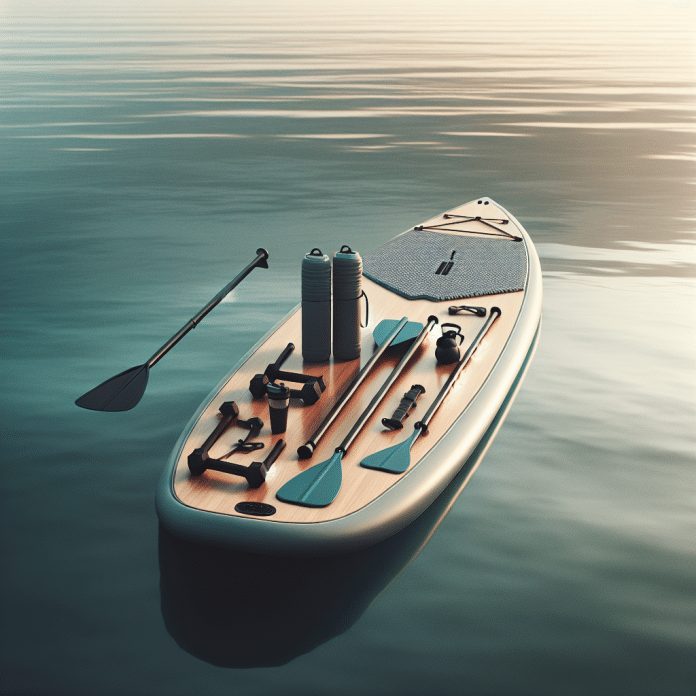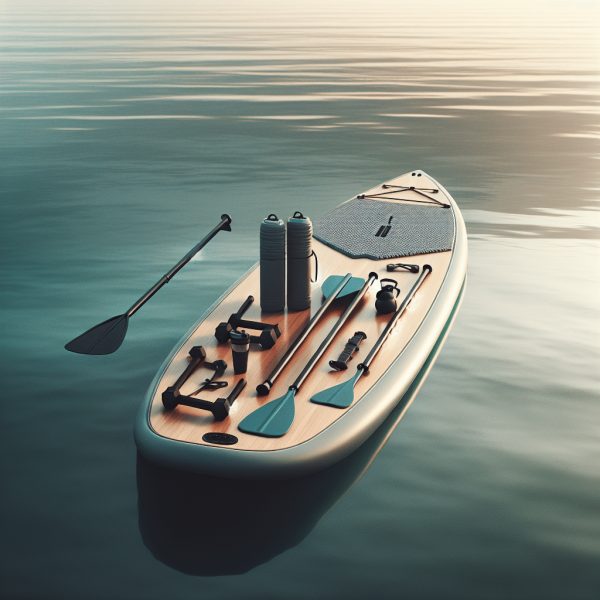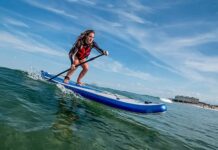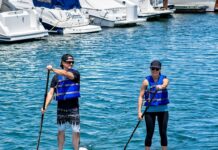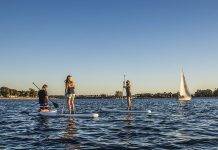We’re here to answer the burning question that many of you may have: do you need to be able to swim in order to fully embrace SUP fitness? SUP, short for Stand-Up Paddleboarding, has been gaining popularity as a fun and effective way to exercise on the water. But with any water-based activity, safety is a key concern. So, let’s jump right in and find out whether swimming skills are a prerequisite for enjoying this exciting fitness trend.
Benefits of SUP Fitness
Improves Balance and Core Strength
SUP fitness is a great way to improve our balance and core strength. Stand-up paddleboarding requires us to engage our core muscles to maintain stability and balance on the board. As we paddle, our core muscles are constantly engaged, helping to strengthen and tone them. This not only enhances our performance on the water but also carries over to our daily lives, improving our overall stability and balance.
Increases Endurance and Cardiovascular Health
Engaging in SUP fitness can significantly increase our endurance and enhance our cardiovascular health. Paddling against the resistance of the water provides a challenging full-body workout that elevates our heart rate and promotes cardiovascular fitness. As we gradually increase our paddling duration and intensity, our endurance levels improve, enabling us to enjoy longer and more challenging paddling sessions.
Enhances Mental Focus and Mindfulness
SUP fitness provides a unique opportunity to enhance our mental focus and promote mindfulness. When we’re out on the water, surrounded by nature and the sound of gentle water lapping against our board, we can immerse ourselves in the present moment. The rhythmic motion of paddling and the need to maintain balance require concentration, allowing us to let go of stress and worries and focus solely on the task at hand. This meditative quality of SUP fitness can help reduce anxiety, promote mental clarity, and improve overall well-being.
Equipment and Safety
Safety Leash and Personal Flotation Device
When engaging in SUP fitness, it is crucial to prioritize safety. One key piece of equipment is a safety leash, which attaches us to the board to prevent separation in case of a fall. This ensures that we stay connected to our board, making it easier to retrieve and reducing the risk of getting separated from it in open water. Additionally, wearing a personal flotation device (PFD) is essential, especially for those who are not strong swimmers. A PFD provides buoyancy and can be life-saving in the event of an emergency.
Choosing the Right Equipment
Selecting the right equipment is essential for a safe and enjoyable SUP fitness experience. The board should be suitable for our skill level and intended use. Beginners may benefit from wider and more stable boards, while more experienced individuals might prefer narrower, faster boards. Paddles should be the right length and adjustable to our height. It is also important to consider the weight capacity of the board to ensure it can adequately support our weight. Properly fitting and comfortable footwear is recommended to protect our feet and provide traction on the board.
Basic Water Safety Skills
Before venturing out on the water for SUP fitness, it is crucial to develop basic water safety skills. It is important to learn how to enter and exit the water safely, how to swim properly, and how to identify and respond to potential dangers. Understanding the basics of water safety, such as knowing how to recognize rip currents, how to use a whistle for distress signals, and how to assist others in need, can greatly enhance our safety while engaging in SUP fitness.
Swimming Skills for SUP Fitness
Basic Swimming Skills
While it is not a prerequisite to be an Olympic swimmer to enjoy SUP fitness, having basic swimming skills is highly recommended. Being able to swim proficiently allows us to navigate in the water confidently and respond effectively to any unforeseen circumstances. Familiarizing ourselves with basic swimming strokes and techniques will provide us with the necessary skills to maneuver in the water and ensure our safety.
Water Confidence
Developing water confidence is an integral part of engaging in SUP fitness. The more comfortable we are in the water, the more enjoyable and safe our experience will be. Building water confidence can be achieved through gradual exposure to water activities, practicing floating and treading water, and working on our breathing techniques. Developing water confidence allows us to relax and focus on maximizing our SUP fitness experience rather than feeling anxious or unsafe in the water.
Importance of Swimming for Safety
Swimming plays a vital role in ensuring our safety during SUP fitness activities. In the event of a fall or loss of balance on the board, knowing how to swim allows us to stay afloat and navigate back to our board or reach safety. Additionally, swimming skills enable us to assist others in need or call for help if necessary. Developing strong swimming skills not only enhances our safety but also provides us with the ability to fully enjoy and participate in SUP fitness without fear or hesitation.
Supervised vs. Unsupervised Sessions
Benefits of Supervised Sessions
Engaging in supervised SUP fitness sessions offers several advantages, especially for beginners or those who are not as confident in their swimming abilities. Supervised sessions provide the opportunity to receive guidance and instruction from experienced professionals who can ensure our safety and teach us proper techniques. Having an instructor present also allows for immediate response and assistance in case of emergencies, providing peace of mind and a supportive learning environment.
Factors to Consider for Unsupervised Sessions
While supervised sessions offer many benefits, some individuals may prefer the flexibility and independence of unsupervised sessions. However, it is essential to consider our own swimming abilities, experience level, and familiarity with the water. Engaging in unsupervised sessions requires a higher level of self-awareness and responsibility for our safety. It is crucial to assess our skill level, adhere to safety guidelines, and be prepared to handle any potential risks or emergencies that may arise.
Importance of Having a Buddy
Regardless of whether we choose supervised or unsupervised SUP fitness sessions, having a buddy is highly recommended for safety purposes. A buddy can provide assistance and support in case of unexpected situations or emergencies. They can help with navigation, offer guidance, and provide an extra set of eyes to ensure our well-being. Having a buddy also adds an element of enjoyment and companionship, making the SUP fitness experience more engaging and social.
Water Depth and Safety Precautions
Shallow Water Training
Shallow water training is an excellent way to build confidence and develop skills for SUP fitness. Training in shallow water allows us to touch the bottom and feel more in control, reducing any fear or anxiety about being in deeper water. It provides an opportunity to practice balance, paddle techniques, and falling safely. Shallow water training also allows for easier recovery of the board in case of a fall, making it a safe and controlled environment for learning and improving our SUP fitness abilities.
Deep Water Training
As we become more comfortable and proficient in SUP fitness, deep water training becomes an important part of our progression. Deep water training allows us to experience different types of water conditions, such as waves or currents, which may not be present in shallow water. It challenges us to apply our skills and techniques to navigate through more dynamic and unpredictable environments. However, it is crucial to ensure that we have the necessary swimming skills and confidence to handle deep water conditions safely.
Safety Tips for Open Water
When venturing into open water for SUP fitness, it is essential to take certain safety precautions. It is crucial to be aware of and understand the local weather and water conditions. Checking the forecast, understanding tidal patterns, and being aware of potential hazards such as rip currents or marine life are important. Carrying a whistle or a signaling device can also be beneficial in case of emergencies. It is important to familiarize ourselves with the local rules and regulations regarding water activities and to always let someone know our plans and estimated return time.
Common Concerns
Fear of Water
Many individuals may have a fear of water, which can be a barrier to engaging in SUP fitness. It is essential to approach this fear gradually and seek support if needed. Working with a qualified instructor who understands our concerns and can provide guidance and reassurance can be immensely helpful. Gradually increasing our exposure to water activities, practicing relaxation techniques, and focusing on building water confidence can help overcome the fear and allow us to enjoy the benefits of SUP fitness.
Alternative Fitness Options
For individuals who are unable to swim or prefer not to engage in water-based activities, there are alternative fitness options available. These may include land-based exercises such as yoga, Pilates, or strength training. Incorporating balance and core strengthening exercises into our routine can also help us reap some of the benefits associated with SUP fitness. While these alternatives may not provide the exact experience of being on the water, they can still contribute to overall fitness and well-being.
Adapting SUP Fitness for Non-Swimmers
Non-swimmers can still enjoy SUP fitness by taking additional safety precautions and working closely with experienced instructors. Utilizing safety equipment such as a PFD and a safety leash is crucial to provide buoyancy and prevent separation from the board. Staying in shallow water and practicing in calm conditions can also mitigate the risks. Non-swimmers should focus on developing water confidence, learning basic swimming skills, and gradually progressing at their own pace under the guidance of a qualified instructor.
Training Preparation and Techniques
Paddle Techniques and Strokes
Learning proper paddle techniques and strokes is essential for efficient and effective SUP fitness. Understanding the different strokes, such as the forward stroke, sweep stroke, and draw stroke, allows us to navigate various water conditions and control our direction. Engaging the core muscles, using proper body posture, and maintaining a steady rhythm are key components of effective paddle techniques. Working with a qualified instructor or participating in SUP fitness classes can help us master these techniques and maximize our performance on the water.
Warm-up and Stretching
Before engaging in SUP fitness, it is important to warm up our muscles and prepare our body for exercise. This can be done through a dynamic warm-up routine that includes movements such as arm circles, leg swings, and torso rotations. It is also crucial to incorporate stretching exercises, focusing on the upper body, back, and lower body, to improve flexibility and prevent injuries. Taking the time to warm up and stretch before each session helps improve performance, reduce muscle soreness, and enhance overall safety.
Building Strength and Stamina
SUP fitness places demands on our muscles and cardiovascular system, making it important to build strength and stamina. Including strength training exercises, such as planks, squats, and lunges, in our fitness routine helps strengthen the muscles used during paddling and promotes overall stability. Additionally, incorporating cardiovascular exercises, such as swimming, cycling, or running, can help improve endurance and enhance our overall performance. Gradually increasing the intensity and duration of our workouts allows us to build strength and stamina progressively.
Learning to Swim for SUP Fitness
Swimming Lessons
Learning to swim is highly recommended for individuals who wish to engage in SUP fitness. Taking swimming lessons allows us to acquire the necessary skills and techniques to swim confidently and effectively. Working with a qualified swim instructor who can assess our abilities and provide personalized instruction is the best way to learn proper swimming techniques. Swimming lessons focus on improving stroke techniques, breathing control, and water safety skills, providing a solid foundation for engaging in SUP fitness.
Water Confidence Exercises
Building water confidence is a crucial component of learning to swim for SUP fitness. Water confidence exercises help us become comfortable and at ease in the water, allowing us to enjoy our SUP fitness experience fully. Some exercises may include floating on our backs, submerging our faces in the water, and gradually increasing the depth at which we are comfortable. These exercises, combined with proper breathing techniques, help develop our water confidence and enhance our swimming abilities.
Gradual Progression
Learning to swim and preparing for SUP fitness should involve a gradual progression. It is important to start with basic swimming skills and gradually increase the complexity and intensity of our swimming exercises. As we become more comfortable and proficient in the water, we can gradually introduce SUP fitness activities, starting with shallow water training and progressing to deeper water as our skills and confidence develop. Gradual progression allows us to build a strong foundation and ensures our safety throughout the process.
Supervision and Lifeguard Support
Training Facilities with Lifeguard Support
When engaging in SUP fitness, choosing training facilities with lifeguard support can provide an added level of safety. These facilities typically have trained lifeguards on duty who are equipped to respond to emergencies and provide assistance if needed. Having lifeguard support enhances our overall safety and provides peace of mind during our SUP fitness sessions. It is important to inquire about the availability of lifeguards when selecting a training facility or location for SUP fitness.
Supervised Swim Training Sessions
Some training facilities or instructors offer supervised swim training sessions as part of their SUP fitness programs. These sessions provide the opportunity to develop and improve swimming skills in a structured and supervised environment. Supervised swim training sessions may include drills to enhance stroke techniques, endurance-building exercises, and water safety skills. Having an experienced instructor present during these sessions ensures proper guidance and instruction, allowing us to progress in our swimming abilities and prepare for SUP fitness.
Importance of Lifeguards for Safety
Lifeguards play a crucial role in ensuring our safety during water-based activities such as SUP fitness. Their training and expertise enable them to respond quickly and effectively in case of emergencies. Lifeguards can provide immediate assistance, perform water rescues if necessary, and offer guidance on water conditions and safety measures. Their presence provides a sense of security and adds an extra layer of protection while engaging in SUP fitness. It is always important to follow any instructions or warnings provided by lifeguards to ensure our safety and well-being.
Conclusion
Swimming skills and safety go hand in hand when it comes to enjoying SUP fitness. While it is not mandatory to be an expert swimmer, having basic swimming skills and water confidence greatly enhance the overall experience. SUP fitness offers numerous benefits, including improved balance and core strength, increased endurance, and enhanced mental focus. By prioritizing safety, selecting the right equipment, and progressing at our own pace, we can fully enjoy the wonders of SUP fitness and reap its many rewards. For non-swimmers or those with a fear of water, there are alternative fitness options available, and adaptations can be made to engage in SUP fitness safely. Ultimately, with a focus on safety and proper preparation, swimming skills can contribute to the success and enjoyment of our SUP fitness journey.

